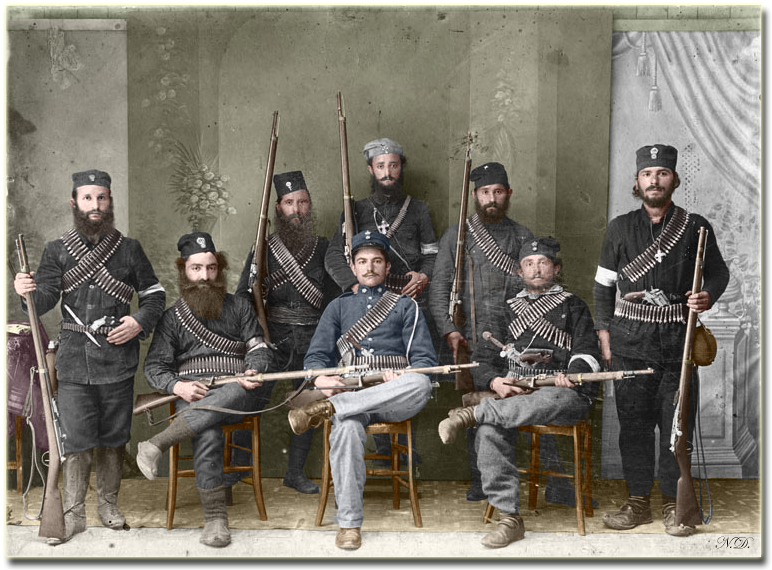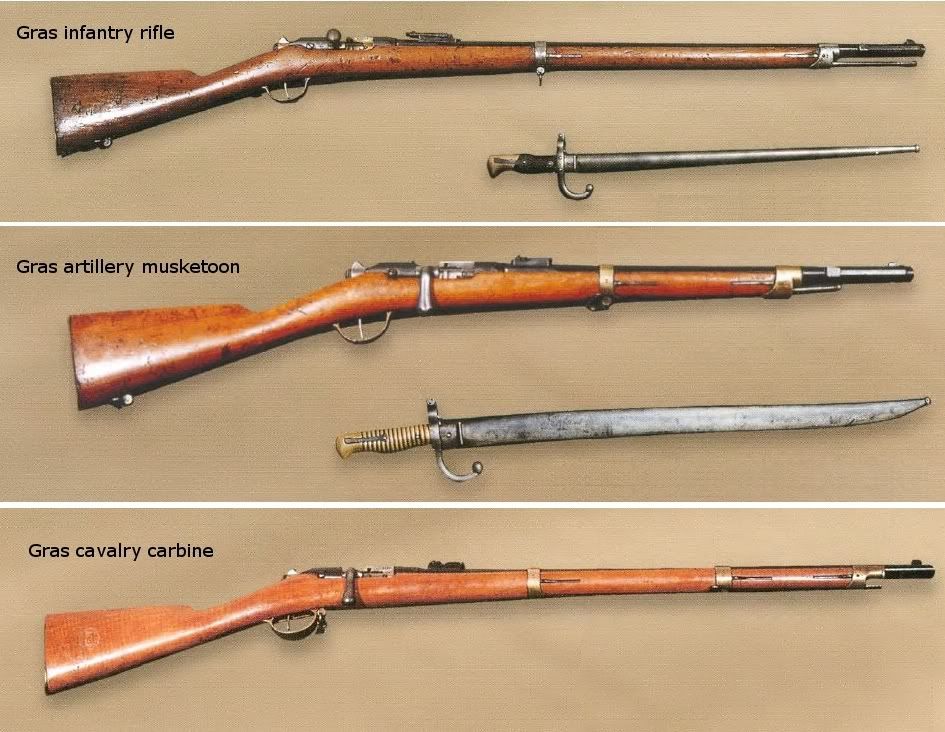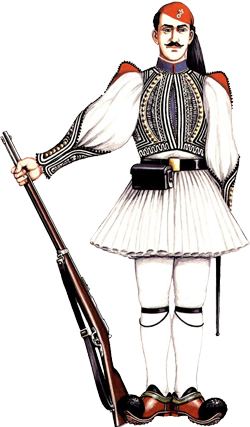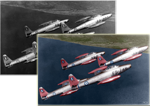 The Gras rifle is an example of military equipment that reached legendary status in Modern Greece. Despite the fact that it could fire only one shot at a time, its robustness and lethality made it a favourite weapon of guerilla fighters for 70 years, from the local revolts against the Ottoman Empire to the resistance against the Germans. In fact, the name "Grades" (Γκράδες) entered the Greek language to represent all kinds of rifles and was used in this manner until a few decades ago. The name "gradia" (γκραδιά) meant the shot of a Gras. Also, weak students and people that were not intelligent were often called "Grades" (Γκράδες). The colourised photo above shows guards of a Greek monastery in Mount Athos after having repelled Bulgarian invaders (1913). Some are possibly monks and there is one Gendarme among them. The front row, from left to right, carry Gras rifle, Gras cavalry carbine, two Gras musketoons and Gras rifle, while all three at the back carry Gras rifles.
The Gras rifle is an example of military equipment that reached legendary status in Modern Greece. Despite the fact that it could fire only one shot at a time, its robustness and lethality made it a favourite weapon of guerilla fighters for 70 years, from the local revolts against the Ottoman Empire to the resistance against the Germans. In fact, the name "Grades" (Γκράδες) entered the Greek language to represent all kinds of rifles and was used in this manner until a few decades ago. The name "gradia" (γκραδιά) meant the shot of a Gras. Also, weak students and people that were not intelligent were often called "Grades" (Γκράδες). The colourised photo above shows guards of a Greek monastery in Mount Athos after having repelled Bulgarian invaders (1913). Some are possibly monks and there is one Gendarme among them. The front row, from left to right, carry Gras rifle, Gras cavalry carbine, two Gras musketoons and Gras rifle, while all three at the back carry Gras rifles.The Gras is mentioned in numerous works of literature and in folk songs.
Operational History
1877 - Greece purchases about 60,000 Gras rifles from Steyr.
22 March 1886 - Last recorded order (1,000 Gras rifles). In total 129,000 have been bought since 1877 (118,000 infantry rifles, 6,000 artillery musketoons and 4,800 cavalry carbines).
24 Jul. 1923 - At the time of the Treaty of Lausanne, the Greeks have 77,000 Gras rifles & carbines, which corresponds to about 25% of the total number of rifles.
28 Oct. 1940 - At the time of the Italian invasion, the Greeks have 60,000 Gras rifles, which corresponds to about 13% of the total number of rifles.
Specifications 
Greek Gras Mle 1874 infantry rifle
Weight: 4.2 kg
Length: 1.32 m
Barrel Length: 0.82 m
Caliber: 11 mm
Action: Bolt-action
Feed System: Single shot
Muzzle velocity: 450 m/s
Greek Gras Mle 1874 artillery musketoon
Weight: 3.3 kg
Length: 0.99 m
Barrel Length: 0.49 m
Caliber: 11 mm
Action: Bolt-action
Feed System: Single shot
Muzzle velocity: 410 m/s
Greek Gras Mle 1874 cavalry carbine
Weight: 3.75 kg
Length: 1.171 m
Barrel Length: 0.72 m
Caliber: 11 mm
Action: Bolt-action
Feed System: Single shot
Muzzle velocity: 430 m/s
For gamers and game designers
At the time of its introduction, the gras was a very potent rifle. Later, it was considered too slow in comparison to more modern rifles. Still, although it could fire only one shot at a time, its 11mm caliber made it particularly lethal.
For modellers
Being a close ally of the French, Greece had tried to order Gras rifles from them, but at the time France was frantically re-arming as a result of the disastrous Franco-Prussian war and could not supply Greece. Then, the Greeks turned to Austrian Steyr for Gras rifles. The Gras rifles produced by Steyr for Greece were identical to the French Gras rifles, with the exception of the left receiver flat that is marked with Styer proofs and the left buttstock that carries a Greek cartouche. The rifle is chambered for the French Mle 1874 Gras cartridge.
The Gras Musketoons are a bit shorter than the rifles and the carbines are practically identical to the French Gras cavalry carbines, but with brass buttplate and barrel bands and turned down bolt handle.

Why did the Greek Army go back to straight bolt head from curved around the rifle bolt head for the Mannlicher-Schonaeur rifles? Straight out bolt heads makes rapid fire much more awkward.
ReplyDeleteThe Mannlicher-Schoenauer was a significant improvement for the Greeks, since the Gras was single shot rifle. Still, as you observed, it was a very awkward design that no major nation adopted. It is not clear why the Greeks bought it, but the fact that Steyr produced many of the Greek Gras means that it was easier for them to convince the Greeks to buy the Mannlicher-Schoenauer. That's just a guess though. In any case, the Greeks rarely bought something that was good value for money.
ReplyDeleteVirtually all the rifles of the era have straight bolt, that is not "going back",
ReplyDeleteas it was not an option.
Notice that the Gras rifle had straight handle too. Instead the carbines have turned down bolt, the main reason is to make them easier to carry on the back by cavalry troops and gunners, has little to do with rapid firing.
also allow me to disagree with the unqualified remark "it was a very awkward design" about the M-S. Quite the opposite, the spool magazine and Mannlicher bolt are equal or even smoother than the extremely widely used Mauser design, it derives from a
sporting gun and is highly regarded. More info in the M-S article.
Could you post the link to the M-S article please? I'm not sure which one you are referring too.
ReplyDeleteThe MS was a good rifle for a bolt action type. Quality was very good, the rotary bolt was a very smooth action. Only issues with it IMO are the straight bolt which made rapid fire difficult (germans got rid of that on the Mauser after WW1) and a barrel length which was too long on the infantry rifle by WW2 standards (29 inches when most WW2 rifles had 24-25 inche barrels). Had those two issues been corrected the M-S would have been a far better rifle.
ReplyDeleteGentlemen the MS was most probably one of the finest bolt rifles ever made.Just too expensive.
ReplyDeleteThe Schonaeur rotary system was a great improvement for rimmed cartridges, but offered no real benefit to a modern rimless cartridge. The MS was a great weapon but unnecessarily complicated, at least as a military weapon. I like the uniqueness of this "Greek" rifle, but it was not the best option. The cartridge itself was probably the best thing about it, good enough for an assault rifle, but never utilized properly.
ReplyDelete"In fact, the name "Grades" (Γκράδες) entered the Greek language to represent all kinds of rifles...." why the name "Grades" to represent all kinds of rifles since they used the word tyfekio (τυφέκιο) to represent the rifles
ReplyDelete"The name "gradia" (γκραδιά) meant the shot of a Gras." well.... they didn't need to bastardize (as usual with foreign words) the name of the Gras rifle as "gradia"
"Also, bad students and people that were not intelligent were often called "Grades" (Γκράδες)." fancy calling people that are not intelligent enough that way by the "smart" ones!
ReplyDelete"bad" students don't exist actually, there are the ones that don't want to learn and the ones that want to learn!
and grade means something that has value after all
I have just bought a very nice Gras 1874 bayonet to suit the Gras rifle and it's very well made. It was great to learn some of the history surrounding the rifle though, and now I might keep an eye out to see if I can find a Gras rifle to buy. Regards, Ron in Australia.
ReplyDeletewho made the 10 round gravity feed magazine for the Gras,and did it everr see any use ?
ReplyDeleteYou guys read wiki too, huh?
ReplyDeletegrass rifle is a new word for me. greece army seem to be intelligent.
ReplyDeletedid anyone notice that the cavalry carbine in the photo has the rear swivel on the butt instead of the trigger guard ?
ReplyDeleteGentlemen the MS was most probably one of the finest bolt rifles ever made.Just too expensive.
ReplyDeleteVector would deal with the rest like kwc the barrel, grips and the trigger.
ReplyDelete